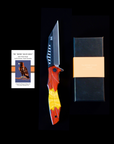
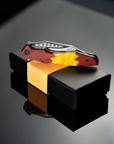
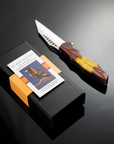
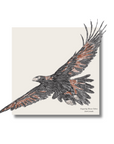
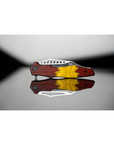
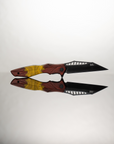
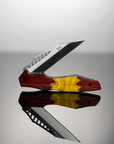
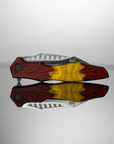
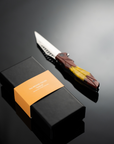
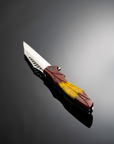
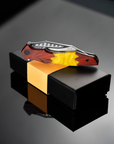
"Evan" | The Wedge Tailed Eagle EDC Pocket Knife
Scientific name: Aquila audax
Indigenous name: Waalitj (Noongar), Bunjil (Kulin) and many more
Koi name: Evan

The largest bird of prey in Australia, the Wedge Tailed Eagle is best known for its striking appearance and it's strength and power (Sam once saw one pick up and carry away a wild goat while driving from Broken Hill to Lake Mungo in outback New South Wales.)
The Australian Wedge-tailed Eagle mates for life. Once they have paired up the Wedge-tailed Eagle will find a large territory and defend it together. They will also share the duties of caring for their chicks and maintaining their nests. Much like its' namesake, you and your Wedge Tailed Eagle Pocket Knife will last forever.

In Central and Western Victorian Aboriginal culture, Bunjil is the name of the creator of the land, water, animals and sky. Once Bunjil was satisfied and had completed everything including people and lore, he turned himself into a Wedge-tailed Eagle so he could soar above the land that he created, keeping an eye on everyone and everything.

The Wedge-tailed Eagle holds a connection to Aboriginal Victorians. When you see Bunjil you feel safe, a connection knowing that you do not walk this country alone, you are under the guidance and protection of a greater presence, a creator spirit.


We designed the Wedge-Tailed Eagle to be a fusion of Art, Design, Engineering and Style that brings function to your pocket for the rest of your life.
Specifications.
Blade Length: 96mm (3.77")
Overall Length: 216mm (8.14")
Folded Length: 120mm (4.33")
Blade Thickness: 3mm (0.09")
Weight: 115g (4.05oz)

Blade Type: Wharncliffe
Scale Material: Redgum with yellow resin
Blade Hardness: 58HRC

Clip Material: CK1055 Spring Steel (Heat treated to 44 HRC)
Hardware: Black Passivated screws & Clip
Blade Grind: Triple Bevel & finger grip slots
Blade Grind: 50/50
Pivot assembly: Caged Ceramic ball bearing washer
Opener: Top Flipper Tab
Lock Type: Liner Lock
High above the brown paddock on a calm and windless day
The huge dark brown bird with wedge tail is eyeing the landscape for prey
He kills living creatures and scavenges on the dead
The great wedge tailed eagle Aussie born and bred.
The great feathered emperors of the southern sky
The landscape below them is bare, brown and dry
And for prey scanning the landscape they hover and fly
The huge and airborne hunters with death in their cry.
They nest in remote places and their nests few do see
A huge structure of sticks lined with green leaves high or low on a tree
They lay two to three pale eggs blotched purply brown
The birds never seen in the parks of the Town.
From human habitation their safe distance they keep
And the farmers do not like them they say they kill sheep
And despite persecution as a species they thrive
And as well as eating carrion of course they must kill to survive.
We produce durable, high-quality knives and products for both culinary and utility use.
We stand behind the craftsmanship of our knives with this limited warranty.
All Koi Knives products are warranted to be free from defects in materials and workmanship during the period of one year from the original date of purchase by the end user.
Should a manufacturing defect arise within the warranty period, We will repair
or replace the knife at our discretion without charge.
Please note: This warranty does not cover damage resulting from improper use or care, accidents, modification, commercial use, neglect, or regular wear and tear over time. We are not responsible for knives that have been damaged from misuse such as dropping, improper cleaning methods (like putting the knife through a dishwasher), or excessive force.
If you have any warranty questions or queries please feel free to contact us.
Please note: We recommend washing blades by hand using warm soapy water and drying them straight away or in any way that does not have water pooling on the blade.
Handles can be oiled using a natural oil such as a Camellia oil.
WARNING: You must be at least 18 years of age to purchase any knives from our store or website - whether it be kitchen, outdoor, or pocket knives.
We ship orders on Tuesdays and Thursdays via Australia Post.
Example: If you place your order on Thursday at 9:30pm, we will ship it the following Tuesday.
Orders within Australia should arrive within a week.
International orders can take between 1-4 weeks to arrive.
Tracking information will be sent to you via Australia Post when your order has been dispatched.
*Only if an email address has bee provided.
Express shipping: If you are wanting your order in a hurry please add a note in with your order and we can upgrade you to express shipping for free.
Or you can email ramon@koiknives.com
*Only for Australian orders
International Orders: Please note there may be additional taxes and duty applied by customs in your country.
Unfortunately we can't tell you how much this would be as each country is different.
A handy guide to use is https://www.simplyduty.com/import-calculator/
YOU MUST BE 18+ YEARS TO PURCHASE A KNIFE
The knives sold by Koi are intended for culinary and food preparation use only.
While robustly constructed, knives can potentially cause harm if misused or used for unintended purposes.
Koi does not assume any liability for damages or injuries that result from improper, dangerous or illegal use.
It is the responsibility of the purchaser to use Koi knives carefully and as directed, store them safely and keep them away from unsupervised children.
By purchasing from Koi, you agree that any misuse of the products is solely your responsibility.
Koi shall not be held responsible or assume any liability in the event of accidents due to disregarding safety instructions or using the product in a way other than its intended use.
We appreciate your support of our small business and hope you enjoy cooking safely with your new Koi knives for many years to come.
Please contact us if you have any other questions.
"Stay sharp and have a knife day"
This knife is built to last with minimal maintenance.
But you still need to look after the knife.
1. Keep the blade nice and dry
It’s important to properly care for and maintain the knife blades. Extended exposure to moisture can potentially cause corrosion in even the most resilient steels over time. It’s essential to dry blades thoroughly after cleaning and avoid prolonged contact with water whenever possible.
The high-carbon steel core of the our knives also requires special care. Carbon steel is more prone to rust if moisture is not fully removed. Be sure to wipe away any moisture on the blade.
When hand washing is necessary, use warm water and avoid soaking the knives for extended periods. While hot water alone won’t typically damage the blade, sudden temperature changes can cause cracking at the microscopic level. Extreme hot or cold should be avoided.
By keeping blades clean and dry, and limiting exposure to moisture, your knife can maintain their corrosion resistance and withstand daily use for many years of dependable performance.
2. Do not put the knife through the dishwasher.
Please.
Do not put your knife in the dishwasher.
Here are a few key reasons why we don't recommend putting your new knife in the dishwasher:
Heat - The high heat of a dishwasher drying cycle can cause microscopic damage and weakening of the blade over time. High carbon steels like VG10 are more vulnerable to heat-related damage.
Moisture - Prolonged exposure to moisture in the dishwasher isn't fully controlled and can lead to rust or corrosion developing on the blade more easily than hand-washing. Wood and water also do not like each other over time.
Detergents - The harsh detergents and cleaning chemicals used in dishwashers aren't designed with knife blades in mind and could potentially cause unwanted reactions or deterioration of protective blade coatings.
Movement - The agitation and bouncing around of knives in a dishwasher creates risk of nicks or dulling of the cutting edge from contact with other dishes.
Aesthetics - Over time, dishwashers may cause discoloration or other undesirable visual changes to the blade appearance or handle.
Hand-washing allows for more gentle, careful cleaning without extended heat or chemical exposure - helping to maintain the VG10 steels' sharpness and corrosion resistance for longer. Taking the extra minute for hand washing is best for your quality knife.
3. Don't use pull through or machine sharpeners.
There are a few key reasons why pull-through/electric knife sharpeners are not recommended for high-carbon steel chef's knives:
They can remove too much metal. High-carbon steels are harder and more brittle than softer stainless steels. Aggressive sharpeners can easily remove too much steel, thinning and damaging the blade edge over time.
They can create a rounded/rolled edge. Pull-through sharpeners can push the edge inward, rounding it rather than honing a sharp, angular apex. This diminishes cutting performance.
Improper angle. It's hard to set the proper angle consistently for each knife with an electric sharpener. An improperly aligned edge won't hold its sharpness as well. We sharpen the nearly all our knives at 15°
Risk of overheating. The friction from an electric sharpener, especially on hard carbon steels, carries a risk of overheating and potentially ruining the blade's temper or microstructure.
Better options exist. Whetstone sharpening allows for precise angles, control over steel removal, and developing a fine, polished edge that stays sharper longer than a pull-through can provide.
For high-performance knife blades like high-carbon, it's best to use more precise and gentle sharpening methods that don't deform or damage the metallurgy of the knife edge.
Whetstones are our preferred method of sharpening.
4. Hone it using a ceramic rod
There are a few key reasons we recommend only using a ceramic honing rod on Koi Knives:
Hardness. VG10 steel is extremely hard, around 61-62 on the Rockwell scale. A softer steel or diamond honing rod could potentially scratch or damage the blade edge during use. Ceramic is harder than the knife steel.
Edge alignment. Ceramic honing rods gently realign the edge of the knife without removing any material. This helps maintain the factory angle and honed cutting geometry over time. Other methods may change the angle.
No burrs. As a harder material, ceramic won't roll or form burrs on the knife edge like other honing steels can. Burrs lead to diminished cutting performance.
Smooth surface. Ceramic rods offer an exceptionally smooth sliding surface, which reduces friction and potential for burning/overheating the edge during honing strokes.
Longevity. Hardest of all honing materials, ceramic will also last essentially the lifetime of the knife without wearing down from use like softer steels can.
For high-performance supersteels like VG10 that we're using in our knives, only ceramic honing maintains the pristine edge geometry without risk of micro-damage, burrs or changing the factory-set angle over numerous sharpening cycles.
5. Care for the handle
It's important to keep in mind that wood, like many natural materials, is vulnerable to the effects of excess water exposure. When wooden handles get wet, they tend to expand slightly and then contract again as they dry. Repeated cycles of expansion and contraction can cause microscopic cracks to form in the grain of the wood.
For this reason, we recommend carefully hand washing your handles to minimise water contact as much as possible. A damp cloth is preferable to soaking or submerging. Thoroughly drying the handles afterwards also makes sure no residual moisture gets trapped.
With proper care, the wooden handle of your knife will maintain its attractiveness for years of use.
But exposing them to continuous wet environments or submerging them could expedite crack development.
By avoiding prolonged water submersion, the wood handles can be preserved looking as fine as the day they were crafted.
6. Do not put your knife through the dishwasher.
Just in case you missed it the first time.
Do not put your knife in the dishwasher.
Follow these steps and your new knife will treat you well for years to come.












